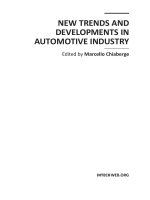New trends and developments in automotive industry Part 1 docx
Bạn đang xem bản rút gọn của tài liệu. Xem và tải ngay bản đầy đủ của tài liệu tại đây (1.33 MB, 30 trang )
NEW TRENDS AND
DEVELOPMENTS IN
AUTOMOTIVE INDUSTRY
Edited by Marcello Chiaberge
New Trends and Developments in Automotive Industry
Edited by Marcello Chiaberge
Published by InTech
Janeza Trdine 9, 51000 Rijeka, Croatia
Copyright © 2011 InTech
All chapters are Open Access articles distributed under the Creative Commons
Non Commercial Share Alike Attribution 3.0 license, which permits to copy,
distribute, transmit, and adapt the work in any medium, so long as the original
work is properly cited. After this work has been published by InTech, authors
have the right to republish it, in whole or part, in any publication of which they
are the author, and to make other personal use of the work. Any republication,
referencing or personal use of the work must explicitly identify the original source.
Statements and opinions expressed in the chapters are these of the individual contributors
and not necessarily those of the editors or publisher. No responsibility is accepted
for the accuracy of information contained in the published articles. The publisher
assumes no responsibility for any damage or injury to persons or property arising out
of the use of any materials, instructions, methods or ideas contained in the book.
Publishing Process Manager Iva Lipovic
Technical Editor Teodora Smiljanic
Cover Designer Martina Sirotic
Image Copyright Blaz Kure, 2010. Used under license from Shutterstock.com
First published January, 2011
Printed in India
A free online edition of this book is available at www.intechopen.com
Additional hard copies can be obtained from
New Trends and Developments in Automotive Industry, Edited by Marcello Chiaberge
p. cm.
ISBN 978-953-307-999-8
free online editions of InTech
Books and Journals can be found at
www.intechopen.com
Chapter 1
Chapter 2
Chapter 3
Part 2
Chapter 4
Chapter 5
Chapter 6
Preface IX
Industrial Production Technology 1
Data Mining and Intelligent Agents for Supporting
Mass Customization in the Automotive Industry 3
Efthimia Mavridou, Dimitrios Tzovaras, Evangelos Bekiaris,
Pavlos Spanidis, Maria Gemou and George Hassapis
Automotive Testing
in the German-Dutch Wind Tunnels 17
Eddy Willemsen, Kurt Pengel, Herman Holthusen,
Albert Küpper, et al
Monitoring and Fault Diagnosis in Manufacturing
Processes in the Automotive Industry 33
Roberto Arnanz Gómez, María A. Gallego de Santiago,
Aníbal Reñones Domínguez, Javier Rodríguez Nieto
and Sergio Saludes Rodil
Industrial System Production 59
The Concurrent Role of Professional Training
and Operations Management: Evidences
from the After-Sales Services Information
Systems Architecture in the Automotive Sector 61
Nouha Taifi and Giuseppina Passiante
Human Factors, Ergonomics Model and Application
in Automotive Industries: Focus on Job Satisfaction 79
Siti Zawiah Md Dawal, Zubaidah Ismail, and Zahari Taha
A Sustainable Service Program
for the Automotive Refinishing Industry 89
Andrea Zavala, Rafael Moure-Eraso,
Nora Munguía and Luis Velázquez
Contents
Contents
VI
An Analysis of the Automaker-Systemist Supplier
Relationship in an Automotive Industrial Condominium 107
Mário Sacomano Neto and Sílvio R. I. Pires
Strategic Priorities and Lean Manufacturing Practices
in Automotive Suppliers. Ten Years After. 123
Juan A. Marin-Garcia and Tomas Bonavia
Identifying and Prioritizing Ecodesign
Key Factors for the Automotive Industry 137
Miriam Borchardt, Miguel Afonso Sellitto, Giancarlo Medeiros
Pereira, Leonel Augusto Calliari Poltosi and Luciana Paulo Gomes
Context Analysis for Situation Assessment
in Automotive Applications 161
L. Ciardelli, A. Beoldo and C. Regazzoni
New Concept in Automotive Manufacturing:
A System-based Manufacturing 177
Mohammad A. Omar
Industrial Machinery and Tools 191
Tomography Visualization Methods
for Monitoring Gases in the Automotive Systems 193
Krzysztof Polakowski
FlexLean - Flexible Automation
for Automotive Body Assembly 209
Sven Soetebier, Nicolas Mauser, Fabrice Legeleux and Sönke Kock
Design Developments 221
Sustainable Design of Automotive Components through Jute
Fiber Composites: An Integrated Approach 223
Cristiano Alves, Arlindo Silva, Luis Reis,
Paulo Ferrão and Manuel Freitas
Are Skill Design Structure Matrices New Tools
for Automotive Design Managers? 255
Jean-Pierre Micaëlli and Éric Bonjour
Materials: Analysis and Improvements 265
Effects of Environmental Conditions
on Degradation of Automotive Coatings 267
Mohsen Mohseni, Bahram Ramezanzadeh and Hossain Yari
Chapter 7
Chapter 8
Chapter 9
Chapter 10
Chapter 11
Part 3
Chapter 12
Chapter 13
Part 4
Chapter 14
Chapter 15
Part 5
Chapter 16
Modern Automotive Gear Oils
- Classification, Characteristics, Market Analysis,
and Some Aspects of Lubrication 297
Waldemar Tuszynski, Remigiusz Michalczewski,
Witold Piekoszewski and Marian Szczerek
Development of a New 3D Nonwoven
for Automotive Trim Applications 323
Nicole Njeugna, Laurence Schacher, Dominique C. Adolphe,
Jean-Baptiste Schaffhauser and Patrick Strehle
Automotive Catalysts: Performance,
Characterization and Development 347
Nelcy Della Santina Mohallem,
Marcelo Machado Viana and Ronald A. Silva
Materials in Automotive Application,
State of the Art and Prospects 365
Elaheh Ghassemieh
Chapter 17
Chapter 18
Chapter 19
Chapter 20
Pref ac e
The automotive industry is experiencing a considerable “stress period”, which can lead
to important changes in the whole industry. Many aspects contribute to this situa-
tion, starting from the global recession (unemployment rates, slowing growth, etc.) to
credit meltdown (dependency of car sales on credit, OEM refi nancing, etc.) and fi nish-
ing with globalization aspects (global sourcing, foreign investments, etc.) and “green
challenges” (both for the industry and the fi nal products).
Moreover, the global market developments are infl uencing the whole automotive in-
dustry in diff erent fi elds (volumes, technologies, regional aspects), while the environ-
mental compatibility of car power-trains will lead to huge investments needs for the
innovation of many diff erent technologies.
In this complex scenario, regional environmental regulations (both on production pro-
cess and on fi nal product) will have great infl uence on further technological develop-
ments. For example, Japan and Europe are world leaders with the most severe stan-
dards in terms of gas, fuel and oil economy, while other emerging economies are facing
right now this kind of problem. This obviously means that the approaching techniques
to new vehicle standards are quite diff erent, and emission targets and measures vary
heavily depending also on industry/consumers incentives that will play a big role in
the future E-mobility scenario.
In this new scenario the automotive industry will not only be characterized by original
and historical OEMs, but entirely new players will enter this industry area. Non-OEM
players will introduce skills related to information systems and connectivity, new com-
ponents, new systems or innovation related to energy supply in order to provide solu-
tions directly connected with the end customer (just think about electric vehicles).
Customers are becoming the main factor of this small “revolution” that will lead OEMs
to defeat their original market position and will be placed at the same level of standard
suppliers in order to provide new solutions for the fi nal customer. A clear example
of this new perspective is the E-mobility scenario, where common projects between
OEMs and power suppliers are driving innovation and new products.
In this new perspective, diff erent solutions will help OEMs to innovate this impor-
tant industry and to face the challenges that new markets, regulations, standards
and technologies are introducing. The possible areas of interest will span from en-
gine cooperation, platform and process sharing, development of new business fi elds,
X
Preface
to joint ventures with electric companies and important strategic partnerships with
suppliers.
This book is divided in fi ve main parts (production technology, system production,
machinery, design and materials) and tries to show emerging solutions in automotive
industry fi elds related to OEMs and no-OEMs sectors in order to show the vitality of
this leading industry for worldwide economies and related important impacts on other
industrial sectors and their environmental sub-products.
Thanks to KPMG for important data and industrial analysis.
Marcello Chiaberge
Mechatronics Laboratory – Politecnico di Torino
Italy
Part 1
Industrial Production Technology
1
Data Mining and Intelligent Agents for
Supporting Mass Customization in the
Automotive Industry
Efthimia Mavridou
1,3
, Dimitrios Tzovaras
1
, Evangelos Bekiaris
2
,
Pavlos Spanidis
2
, Maria Gemou
2
and George Hassapis
3
1
Informatics and Telematics Institute, Centre for Research and Technology Hellas, 6
th
km
Charilaou – Thermi Rd., P.O. Box: 60361, P.C.: 57001, Thermi, Thessaloniki,
2
Hellenic Institute of Transport, Centre for Research and Technology Hellas, 6
th
km
Charilaou – Thermi Rd., P.O. Box: 60361, P.C.: 57001, Thermi, Thessaloniki,
3
Department of Electrical and Computer Engineering, Faculty of Engineering, Aristotle
University of Thessaloniki, P.C.:54124 , Thessaloniki,
Greece
1. Introduction
Mass customisation has been said to be the new frontier in business competition (Pine,
1992). The objective of mass customisation is to deliver goods and services that meet
individual customers’ needs with near mass production efficiency (Tseng & Jiao, 2001).
Currently, only few automotive industries have deployed mass customisation systems in
their product design and manufacturing processes. In the current paper, we present such a
mass customization system, designed as an agent-oriented architecture which proposes to
the vehicle customers (of car and truck segments) personalised vehicle configurations
according to their personal affective needs.
Design for performance (i.e. functional design) and design for usability (i.e. ergonomic
design) no longer empower a competitive edge because product technologies turn to be
mature, or competitors can quickly catch up (Khalid & Helander, 2004). Affective design has
become very important in prescribing that designed objects have a meaning that goes
beyond their functional needs (Khalid et al., 2006). Customers actively seek design features
that are important for their emotional satisfaction, and vehicle design must therefore
address customer affective needs. Affective needs are defined as user requirements for a
specific product, driven by emotions, sentiments and attitudes (Khalid et al., 2006).
Understanding customer affective needs is important to ensure a good fit of affective and
functional requirements to design parameters.
Several pieces of research have been presented for supporting affective design such as
Kansei engineering which has been well recognized as a technique of translating consumers’
subjective impressions about a product into design elements (Nagamashi, 1989). (Ishihara et
al., 1995) apply neural network techniques to enhance the inference between Kansei words
and design elements in Kansei design systems. (Matsubara & Nagamachi. 1997) propose to
New Trends and Developments in Automotive Industry
4
develop hybrid expert systems for Kansei design support. (Jiao, 2007) proposes an affective
design framework based on ambient intelligence techniques to facilitate decision-making in
designing customized product ecosystems. In the current paper, a new research focus and
perspective that integrates cognition/thinking and emotion/affect in uncovering customer
needs is deployed, the Citarasa Engineering (CE) (Khalid et al., 2006). It is developed for the
purpose of supporting affective design as an alternative to existing methods such as Kansei
Engineering (Nagamashi, 1989). Citarasa refers to a Malay word which means emotional
intent or a strong desire for a product. For the purpose of discovering the mapping
relationship between customers’ affective needs, defined by their citarasa, and the design
parameters that characterize the design elements of vehicles, data mining techniques were
deployed.
Data mining (DM) enables efficient knowledge extraction from large datasets, in order to
discover hidden or non-obvious patterns in data (Witten et al., 2005). Our motivation for
using DM was based on the hypothesis that the application of the appropriate DM
technique on customer surveys could form a suitable mechanism for the knowledge
extraction representing the correlation between customer affective needs and design
parameters related to the various design elements of vehicles. The extracted knowledge was
then used for the provision of personalised recommendations to customers in collaboration
with the agent-based framework developed and via the web and VR based interfaces
developed in the context of the CATER – STREP project (Annex I-“Description of Work”,
2006). The latter constitutes the second part of the work held. The agent – based system
developed interacts with different modules of the overall integrated system developed in
CATER, in order to support the mass customisation supply chain including suppliers,
factories, subcontractors, warehouses, distribution centres and retailers.
2. Mining of customer survey data
2.1 Data mining process
The aim of the data mining process was to identify the mapping relationship between
customer affective needs and vehicle configurations, with final goal to propose to new
customers’ vehicle configurations according to their personal affective needs. Affective
needs are described by the use of citarasa descriptors (Cd), which are keywords extracted
through probe elicitation surveys and semantic based methods conducted in the scope of
CATER (Annex I-“Description of Work”, 2006).
We consider a vehicle configuration V as a set of design elements:
=
12
[ , , , ]
n
Vdede de.The
term design element (
i
de ) refers to the customizable vehicle parts such as steering-wheel,
wheel-rim, mirrors etc. Each design element
i
de
is characterized by a set of design
parameters (
i
j
dp ) such as color, shape etc. Thus, a design element
i
de is represented as a set
of design parameters,
=
12
[ , , , ]
iii in
de dp dp dp . Each
i
j
dp has a set of possible values. For
example the
=
11
dp material
of the
=−
1
de steering wheel
has the set of values:
[,min,]vinyl alu ium wood . Different values of the design parameters result in different
versions of the design elements, and consequently in different vehicle configurations. We
construct a classification mechanism for predicting the values of each of the design
parameters that satisfy customer affective needs. Specifically, we construct a classification
mechanism for each of the design parameters (
i
j
dp ). Then, by the assistance of the agent-
based framework (section 3) we can propose to the customer vehicle configurations that
correspond to the predicted design parameters, and therefore to the customer affective
Data Mining and Intelligent Agents for Supporting Mass Customization in the Automotive Industry
5
needs. We deploy a classification approach based on association rules. Association rule
discovery refers to the discovery of the relationships among a large set of data items
(Agrawal et al., 1994), while classification focuses on building a classification model for
categorizing new data. Let
=
12
[ , , , ]
n
Iii ibe a set of items and let D be a set of records,
where each record
R is a set of items such that
⊆RI
. An association rule is an implication of
the form →
XY, where
⊂XI
,
⊂YI
and
∩
=∅XY .
X
is the head of the rule and
Y
is the
body. The confidence
c
of a rule is defined as the number of records that contain X and
also
Y (
∩
()count X Y ) divided by the number of records in D that contain X ( ()count X ):
∩
=
()
()
count X Y
c
count X
(1)
Confidence can be interpreted as an estimation of the probability of (|)PX Y . The support s
of a rule is defined as the number of records that contain
X and also Y ( ∩()count X Y )
divided by the total number of records in
D ( ()count R ).
∩
=
()
()
count X Y
s
count R
(2)
Classification based on association rules (also known as associative classification, AC), is a
relatively new classification approach integrating association mining and classification. Several
studies (Li et al., 2001; Yin & Han, 2003 & Sun et al., 2006) have provided evidence that AC
algorithms are able to extract classifiers competitive with traditional classification approaches
such as C4.5. The main steps of an AC classifier are the following (Thabtah, 2007):
Step 1. Discovery of all frequent rules.
Step 2. The production of all class association rules (CARs) that have confidences above the
minimum confidence threshold from frequent rules extracted in Step 1.
Step 3. The selection of one subset of CARs to form the classifier from those generated at
Step 2.
Step 4. Measuring the quality of the derived classifier on test data objects.
In our framework we deploy a variation of the CBA (Liu et al., 1998) algorithm, which is a
typical associative classifier. CBA first generates as candidate rules all the class association
rules exceeding the given support and confidence thresholds using the A-priori algorithm
(Agrawal & Srikant, 1994). After the rule generation, CBA prunes the set of rules using the
pessimistic error rate method (Quinlan, 1987). More specifically if rule’s pessimistic error
rate is higher than the pessimistic error rate of rule then the rule is pruned. In the testing
phase, the best rule whose body is satisfied by the test object is chosen for prediction. We
use a variation of the CBA presented in (Coenen, 2004, b) which replaces the Apriori
algorithm with the Apriori-TFP (Coenen et al., 2004, a) which utilizes a tree structure for
more effective mining of the association rules.
In the following section, we present a case study on the application of the presented data
mining process on data of car customer surveys.
2.2 Case study on car customers
The customer surveys which were conducted in the context of CATER project provided the
data for our study. Those included interview surveys of 140 truck drivers and 261 car
drivers from Europe and Asia (China, Finland, France, Germany, Greece, India, Italy,
New Trends and Developments in Automotive Industry
6
Malaysia, Netherlands, Singapore, Sweden, Switzerland, the UK). We present a case study
on the car customer surveys data.
Each individual car customer was asked to select among different versions of various design
elements. The case study focused on the 4 design elements that the car customers were more
interested to customize. Table 1 includes the design elements (
i
de (1
st
column) and their
related design parameters (
i
j
d
p
) (2
nd
column) that were included in this case study.
Design elements Design parameters
1
de
= wheels
11
dp
= material,
12
dp =number of spokes
2
de =seats
21
dp =material,
22
dp = shape
3
de = steering – wheel
31
dp =material,
32
dp =number of spokes
4
de =side mirror
41
dp = shape
Table 1. Design elements and their related design parameters
For each customer we were provided the citarasa descriptor (
Cd) that described his/her
affective needs, information regarding his/her selections on specific versions of design
elements (and thus in specific values of design parameters) and demographic information
such as the gender, the age, and the geographic region which according to the citarasa
method should also be taken into account. Table 2 includes the respective variables. A
snapshot of our complete dataset is presented in Table 3. Each row corresponds to an
individual car customer response. For example, row 1 corresponds to a male car customer
who comes from Asia, his age is above 55 and his affective needs are described by the
Name Values
Region Europe, Asia
Gender Male, Female
Age 18-24,25-54,55-above
Table 2. Demographic information variables for car customers
Re gion
Gender
Age
Cd
11
dp
12
dp
21
dp
22
dp
31
dp
32
dp
41
dp
Asia Male 55- Classic
Alumi-
nium
Five
Poly-
ester
Flat Wood Three
Angu-
lar
Asia Male 55- Classic
Alumi-
nium
Five
Poly-
ester
Flat Wood Four
Angu
-lar
Asia Female 25-54 Modern
Alumi-
nium
Multi-
ple
Canvas Wide
Alumi-
nium
Three
Cur
-vy
Asia Female 25-54 Cool
Alumi-
nium
Multi-
ple
Canvas
Cur-
ved
Vinyl Three
Recta-
ngular
Europe Female 25-54 Cool Alloy Six Canvas
Cur-
ved
Vinyl
Multi-
ple
Recta-
ngular
Table 3. Snapshot the car customers data set
Data Mining and Intelligent Agents for Supporting Mass Customization in the Automotive Industry
7
citarasa descriptor (Cd)
Classic. The rest of the columns correspond to his selection on
specific design elements and design parameters. For example, in column 5 and row 1 the
customer’s selection on the material of the wheels (Aluminium) is included.
For each design parameter
i
j
d
p
a classification based on association rules was constructed.
As a result, 7 classification mechanisms were constructed to provide a mapping between
customers’ affective needs and the specific design parameter of a design element. Towards
this direction, the customer survey data set was divided to 7 subsets, each one related to a
design parameter, which were provided as training data to the CBA algorithm. The support
s
and confidence
c
thresholds were set to 10% and 50% respectively. Table 4 includes the
number of rules generated by the CBA algorithm for each design parameter
i
j
d
p
. The 2
nd
row refers to the whole set of the generated rules while the 3
rd
row to number of rules that
above the support and confidence thresholds.
Design parameter
11
dp
12
dp
21
dp
22
dp
31
dp
32
dp
41
dp
Numbers of rules generated 141 97 144 84 123 44 110
Number of rules above thresholds
s=10% and c=50%
27 31 24 27 27 19 24
Table 4. Number of rules generated for each design parameter
Besides the classification purposes, the rules generated provided also a meaningful
overview of the associations among data. Table 5 includes the rules generated for the dp
32
(which refers to the number of spokes of the steering-wheel) that were above the support
No.
rule
Rule Confidence
1 Region=Europe and Gender =Female and Cd =Classic -> Three 100.0%
2 Region=Europe and Gender=Female and Cd=Sporty -> Three 100.0%
3 Region=Asia and Gender=Female and Cd=Classic -> Four 100.0%
4 Region =Europe and Age =18-24 and Cd =Cute -> Three 100.0%
5 Region =Asia and Gender = Male and Cd =Cool -> Three 100.0%
6 Region=Asia and Age =18-24 Cd =Classic -> Four 100.0%
7 Region =Asia and Gender=Male and Cd= Modern -> Multiple 100.0%
8 Region=Asia and Age =18-24 and Cd =Sporty-> Multiple 100.0%
9 Age=55-above and Cd=Classic -> Three 100.0%
10 Age =55-above and Cd=Sporty -> Three 100.0%
11 Age =55-above and Cd =Cute -> Multiple 100.0%
12 Gender =Male and Age=18-24 and Cd =Cute} -> Three 100.0%
13 Region=Europe and Cd =Classic -> Three 91.66%
14 Region =Europe and Cd= Sporty -> Three 83.33%
15 Region =Female and Age=25-54 and Cd =Cool -> Four 83.33%
16 Region =Europe and Age =18-24} -> Three 80.0%
17 Region=Europe and Gender =Female and Cd =Cute -> Three 80.0%
18 Region=Asia and Gender=Female and Age=18-24 -> Four 80.0%
19 Default -> Three 0.0%
Table 5. Rules generated for the design parameter dp
32
New Trends and Developments in Automotive Industry
8
and confidence thresholds. For example, rule 1 implies that a female customer who comes
from Europe, and her affective needs are described by the citarasa descriptor
Classic she
would be satisfied with a steering-wheel with three spokes.
2.3 Evaluation
The accuracy of the classifiers was assessed by a
k -fold cross validation (Kohavi et al. 1995)
process. According to this method, the dataset is divided into
k subsets. Each time one of
the
k subsets is used as the test set and the other
−
1k form the training set. The advantage
of this method is that it does not depend on how the data gets divided as each one of the
data instances takes part in the test set once and in the training set
−
1k times. The most
commonly used value for k ,which is used in our study, is 10. The accuracy ( AC ) of the
classifiers is measured by the proportion of the total number of items that were correctly
classified. It is determined using the equation (3):
+
=
+++
TP TN
Accuracy
TP TN FP FN
(3)
The
TP (True Positive) is the number of positive cases that were correctly classified. And the
FP (False positive) is the number of negatives cases that were incorrectly classified as positive.
In proportion, the
TN (True negative) is defined as the number of negatives cases that were
classified correctly and the
FN (False negative) is the number of positives cases that were
incorrectly classified as negative. Figure 1 includes the calculated predictive accuracy of the
classifiers generated for each design parameter
i
j
d
p
.
Fig. 1. Predictive accuracy of classifiers
As it is depicted in Figure 1, most of the classifiers have achieved a level of predictive
accuracy above 50%. The average accuracy of all classifiers is 55,23%. The generated
classifiers form the prediction mechanism which generates for each design parameter a
specific prediction based on the generated rules. Table 6 shows the predicted values for an
individual customer. The example refers to a female car driver from Europe, who belongs to
the age range of 25-54 and would like to have a “Cool” car.
Data Mining and Intelligent Agents for Supporting Mass Customization in the Automotive Industry
9
Design
parameter
Predicted
Values
Design
parameter
Predicted
Values
11
dp
Aluminium
31
dp
Wide
12
dp
Multiple
32
dp
Four
21
dp
Aluminium
41
dp
Angular
22
dp
Canvas
Table 6. Predicted design parameters for a customer
The predicted values are provided as input to the agent-based framework developed (see
following Chapter) and are “interpreted” to configuration elements by the use of the
configuration ontology. Finally, the complete vehicle recommendation is then presented
visually to the user via web and VR based user interfaces.
3. Agent-based framework
3.1 Agent technology
The agent – based system has been developed with a new technology of JADE which is
called Web Service Integration Gateway (WSIG). The objective of WSIG is to expose services
provided by agents and published in the JADE framework as web services, though giving
developers enough flexibility to meet specific requirements. The process involves the
generation of a suitable WSDL for each service-description registered with the Data
Framework and also the publication of the exposed services in a UDDI registry. The Web
Services are becoming one of the most important topics of software development and a
standard for interconnection of different applications.
The WSIG add-on of JADE supports the standard Web Services stack, consisting of WSDL
for service descriptions, SOAP message transport and a UDDI repository for publishing
Web Services using Models (Jade WSIG Guide 2008). As shown in Figure 2, WSIG is a web
application composed of two main elements:
• the WSIG Servlet, and,
• the WSIG Agent.
The WSIG Servlet is the front-end towards the internet world
(Jade WSIG Guide 2008) and is
responsible for:
• Serving incoming HTTP/SOAP requests;
• Extracting the SOAP message;
• Preparing the corresponding agent action and passing it to the WSIG Agent Moreover
once the action has been served;
• Converting the action result into a SOAP message;
• Preparing the HTTP/SOAP response to be sent back to the client.
The WSIG Agent is the gateway between the Web and the Agent worlds
(Jade WSIG Guide
2008) and is responsible for:
• Forwarding agent actions received from the WSIG Servlet to the agents actually able to
serve them and getting back responses.
• Subscribing to the JADE DF to receive notifications about agent registrations / de-
registrations.
• Creating the WSDL corresponding to each agent service registered with the DF and
publishes the service in a UDDI registry if needed.
New Trends and Developments in Automotive Industry
10
Fig. 2. WSIG Architecture (Jade 2008)
Two main processes are continuously active in the WSIG web application:
i. The process responsible for intercepting DF registrations/de-registrations and
converting them into suitable WSDLs. As mentioned, this process is completely carried
out by the WSIG Agent.
ii. The process responsible for serving incoming web service requests and triggering the
corresponding agent actions. This process is carried out jointly by the WSIG Servlet
(performing the necessary translations) and the WSIG Agent (forwarding requests to
agents able to serve them).
The FIPA (Foundation for Intelligent Physical Agents) compliant JADE/LEAP platform
(Jade 2008) adopted allows for an architecture that is:
• Distributed (different platforms);
• Standards based (FIPA, HTTP, XML, RDF);
• Process centric (agents);
• Widely used in ICT (Information and Communication Technologies);
• Open source (possibility of features addition);
• Cross-platform (Operating System, e.g. Linux);
• Variety of message transport protocols.
JADE (Java Agent DEvelopment Framework) is a software framework fully implemented in
Java language (Jade 2008). It aims at the development of multi-agent systems and
applications confirming to FIPA standards for intelligent agents. It includes:
• A runtime environment where JADE agents can “live” and that must be active on a
given host before one or more agents can be executed on the host.
• A library of classes that programmers can use to develop their agents.
Data Mining and Intelligent Agents for Supporting Mass Customization in the Automotive Industry
11
• A suite of graphical tools that allows administrating and monitoring the activity of
running agents.
Each running instance of the JADE runtime environment is called a ‘Container’ as it can
contain several agents. A set of active containers is called a ‘Platform’. A single special Main
Container should always be active in a platform and all other containers register with it
when they start. The Main Container differs from normal containers in the ability of
accepting registrations from other containers. This registration can be done by the two
special agents that start when the main container is launched. These are:
• The Agent Management System (AMS) that provides the naming service and represents
the authority in the platform. The Agent Communication Channel (ACC) is the agent
that provides the path for basic contact between agents inside and outside the platform.
• Standards The Directory Facilitator (DF) that provides a Yellow Pages service by means
of which an agent can find other agents providing the required services. The standard
specifies also the Agent Communication Language (ACL). Agent communication is
based on message passing, where agents communicate by formulating and transmitting
individual messages to each other.
3.2 Agents in the overall CATER architecture
As it has already been mentioned, the CATER architecture is based on agents. Figure 3
shows the connectivity of the agents with the rest modules of the system. More analytically,
the agent is interconnected with three main modules. These are namely: a) the Web
interface, b) the Citarasa engine and c) the DIYD engine of the system. On the Web interface,
the agent allows the user to register and/or login him/herself to the system. Specific entries
are requested by the user, such as the name and surname of the user, desired username and
password and also the occupation, the region, the age and the gender.
The occupation, the region, the age and the gender in specific, constitute the input that is
required by the
Citarasa engine in order to predict a vehicle configuration, customized to the
specific user, classified also per
Citarasa Descriptor (i.e. “Cute”, “Cool”, “Classic”, etc.). The
prediction of the most suitable vehicle configuration is performed through the classification
Fig. 3. Agent Platform internal diagram
New Trends and Developments in Automotive Industry
12
Fig. 4. Agent‘s conceptual architecture
models generated by the data mining process (as described in section 2) which constitute the
knowledge base of the Data Mining module of the
Citarasa engine. All requested entries by
each registered user are collected in the Citarasa engineering database.
The agent is interconnected with the DIYD engine that constitutes the interface of the user
with the Citarasa engine. The DIYD engine requests from the user (via the web interface ) to
choose among a list of
Citarasa Descriptors (i.e. “Cool”, “Cute”, “Classic”, etc.) (Figure 5) that
according to his/her opinion characterise in the most felicitous way his/her overall
preference regarding the vehicle s/he wishes to view and further configure. The DIYD
engine, utilising the output of the
Citarasa engine, finally provides to the user a suggested
vehicle configuration, customised to his/her profile and declared preference, by the means
of web or VR based interfaces (Figure 6).
The agent – based system consists of several functions. Each function is responsible for a
particular activity and these activities are accessible through a special XML file, the WSDL
file. In this file, the client is able to find all the available activities that the agent can perform.
Table 7 below contains the list of the major actions that the CATER agent performs.
These functions are available through the World Wide Web. Any module that needs to
interact with the CATER system has to follow the rules of the above functions in order to
retrieve the required/requested results.
It should be noted that the agent has been designed in such a way so as to support also the
self training of the system. Every time a user completes his/her vehicle configuration
process, the CATER agent stores this information. A specific number of new entries on the
database trigger the update of the knowledge base of the DM module that is responsible for
the vehicle configuration prediction recommended to the user.
Data Mining and Intelligent Agents for Supporting Mass Customization in the Automotive Industry
13
Fig. 5. Selection among a list of Citarasa Descriptors via the web interface
Fig. 6. Proposed configuration via the web interface
Activity
Function Description
Registration setUser( ) This function has a list of attributes as input
(name, surname, username, password, region,
occupation, age, gender) and outputs “0” or “1”
(false or true) which indicates the successful
addition of the data in the database.









